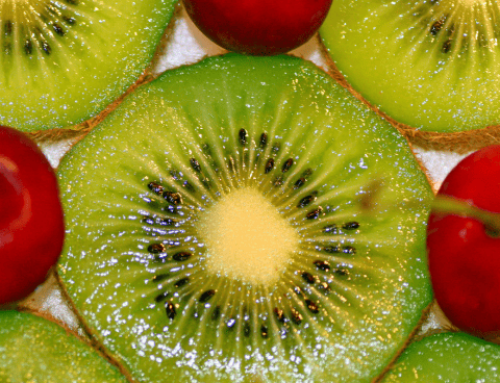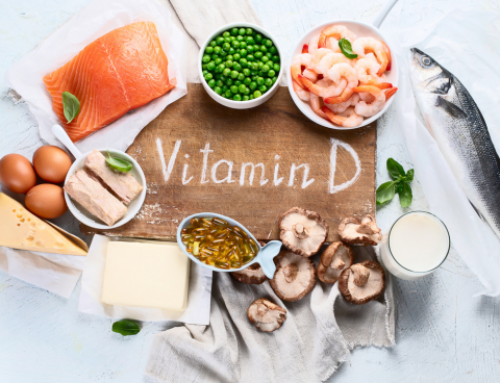Is Halo Top Ice Cream Actually Healthy?
I can confirm that Halo Top ice cream does indeed taste amazing.
After hearing hype for months about this low-calorie, high-protein “healthy” ice cream, I finally caved and bought a pint of their Black Cherry. I devoured it in minutes and was amazed at how much it tasted like traditional ice cream. If I went to a scoop shoppe and someone served me a bowl of Halo Top, I wouldn’t think twice. I would think it was some pretty great ice cream.
But there’s a common saying in the nutrition world—if it’s too good to be true, it probably is. Just because a product’s low in calories doesn’t necessarily mean it’s healthy. Heck, zero-calorie diet soda has its own set of issues. So, is Halo Top ice cream actually healthy? Here’s your answer.
Getting The Facts Straight
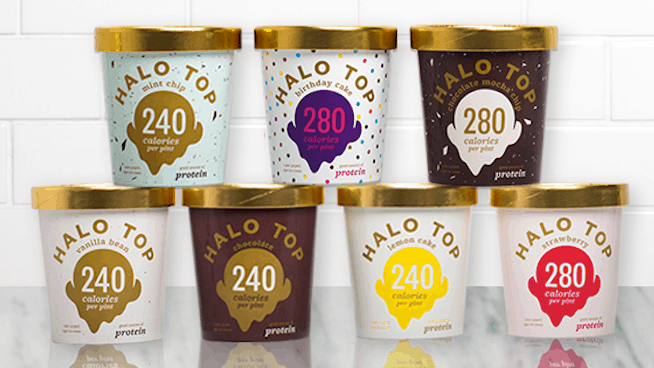
Before we dive into the ingredients in Halo Top, let’s discuss its nutrition facts.
In short, they’re spectacular—at least compared to the nutrition facts for traditional ice cream. Halo Top is currently available in 17 flavors. Each flavor falls in the range of 240-360 calories per pint. Let’s focus on the chocolate variety, since it’s fairly simple.
One pint of chocolate Halo Top ice cream contains:
280 calories, 10 grams of fat, 4 grams of saturated fat, 160 mg of cholesterol, 440 mg of sodium, 48 grams of carbohydrate, 8 grams of fiber, 20 grams of sugar, 20 grams of protein, 40% DV calcium, 16% DV iron.
Now, let’s compare that to one the most popular traditional ice cream brands in the world—Häagen-Dazs. The nutrition facts for one pint of chocolate Häagen-Dazs ice cream:
1,040 calories, 68 grams of fat, 40 grams of saturated fat, 360 mg of cholesterol, 180 mg of sodium, 88 grams of carbohydrate, 4 grams of fiber, 76 grams of sugar, 20 grams of protein, 32% DV calcium, 32% DV iron.
There’s really no contest—Halo Top blows traditional ice cream out of the water in almost every important nutritional category (especially for those concerned with weight management). The calories, fat, saturated fat and sugar totals for Halo Top are a fraction of what’s inside traditional ice cream. Halo Top does this while being just as high in fiber and protein as the traditional brands (if not more so). It’s still ice cream, so it can’t replace veggies, fruit, whole grains, etc. in your diet. But you’ll be hard-pressed to find a delicious dessert with more impressive nutrition facts than Halo Top.
The next question is how the heck do they do it?
Ingenious Ingredients
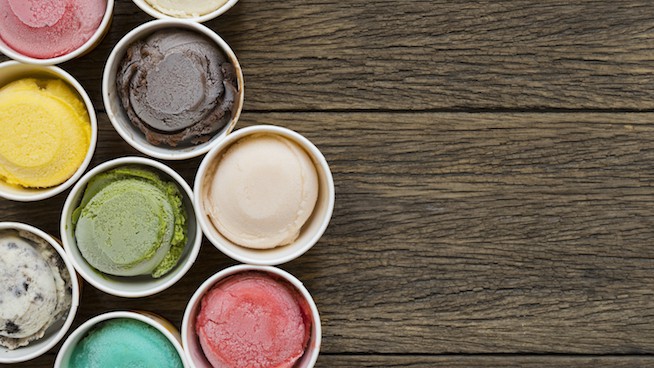
Top view Ice cream flavors in cup on blackground
One reason Halo Top is able to keep their calorie count and sugar totals so low is because, unlike traditional ice cream manufacturers, they actually use a trio of sweeteners in their product.
The most prominent is erythritol, an all-natural sugar alcohol that looks and tastes like sugar yet contains just 0.24 calories per gram. The second most prominent is organic cane sugar—which is basically a fancy way of saying plain ol’ sugar. Sugar contains 4 calories per gram. A pint of Halo Top contains 20 grams of sugar, so 80 of those calories can be directly attributed to its sugar content. The third sweetener is stevia, a plant native to Paraguay that’s long been used as a low-calorie natural sweetener. It contains no calories and is roughly 250 to 300 times the sweetness of sugar.
Let’s crunch the cumulative calorie numbers for these sweeteners:
- Stevia contains no calories.
- The 20 grams of organic cane sugar contribute 80 calories.
- The 20 grams of erythritol (it’s listed under “sugar alcohols” on the nutrition facts panel) contribute about 5 calories.
So Halo Top is able to sweeten their ice cream on a level that tastes similar to traditional ice cream but do so while adding just 85 calories per pint. This is a far cry from the calorie totals traditional ice cream makers rack up with their sweeteners.
Let’s go back to that pint of chocolate Häagen-Dazs. Häagen-Dazs uses just five ingredients in their chocolate recipe (compared to the 12-13 ingredients used in Halo Top), and only one of them is a sweetener. That sweetener is sugar. A pint of chocolate Häagen-Dazs contains 76 grams of sugar. Since a gram of sugar contains 4 calories, that’s a total of 304 calories per pint. Obviously, 304 calories is a lot more than 85.
But the sweeteners alone cannot fully explain why Halo Top’s calorie count is so dramatically lower. That’s because there’s another major factor at play—weight. Halo Top’s ice cream is significantly lighter than Häagen-Dazs, even though you may not necessarily notice that fact when you eat it.
A pint of chocolate Halo Top contains a total of 256 grams of ice cream. A pint of Häagen-Dazs? 408 grams. By weight, that’s about 37 percent less ice cream. If you removed all the extra grams of ice cream you get in a pint of chocolate Häagen-Dazs versus a pint of chocolate Halo Top, that would bring the calorie count of the Häagen-Dazs down to about 655 calories. If Häagen-Dazs used the same blend of sweeteners as Halo Top instead of just plain sugar, it would bring the calorie count down further to 436 calories per pint. Suddenly, the 280 calories in that pint of Halo Top doesn’t seem so unbelievable. It’s not that Häagen-Dazs ice cream is super heavy, either—for example, a pint of Ben & Jerry’s vanilla ice cream (the company doesn’t make plain chocolate) contains 428 grams of ice cream.
The remaining caloric difference can likely be attributed to additional differences in ingredients. Here’s the full list of ingredients for a pint of chocolate Halo Top:
Milk and cream, eggs, erythritol, prebiotic fiber, milk protein concentrate, organic cane sugar, high fat cocoa, vegetable glycerin, sea salt, organic carob gum, organic guar gum, organic stevia.
Here’s the full list of ingredients for a pint of chocolate Häagen-Daazs:
Cream, skim milk, sugar, cocoa processed with alkali, egg yolks.
There’s certainly enough variation between those ingredients to find the extra 150 calories or so that Halo Top managed to shave off. Perhaps they use less milk, cream or eggs in their recipe, which might explain why they turned to other ingredients to achieve the desired texture. Glycerine is a common thickening agent in low-fat foods, and the same goes for guar gum and carob gum. The inclusion of milk protein concentrate could also have been done to make up for the missing protein that comes with having less cream, milk or eggs.
The Verdict
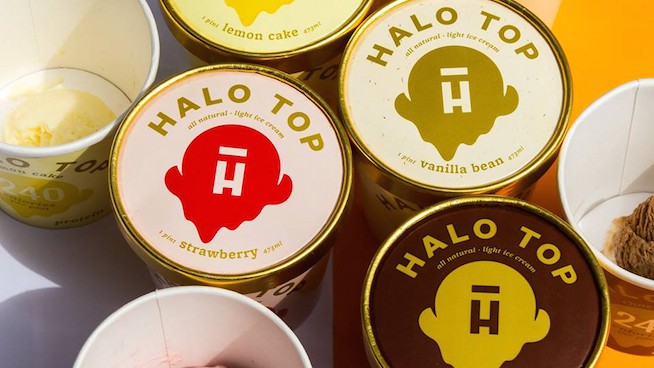
So, is Halo Top actually healthy?
In terms of ice cream, yes. I wouldn’t go as far to say that it’s healthy in general, but downing a pint of Halo Top is a smarter choice than downing a pint of traditional ice cream. However, you have to understand that you’re likely getting less ice cream (in terms of weight) in that pint of Halo Top than you are in a pint of traditional ice cream.
Halo Top uses several low-calorie sweeteners and a fine-tuned recipe to mimic the taste and feel of traditional ice cream while keeping key nutrition facts (calories, saturated fat, sugar, etc.) much lower. Justin Woolverton, Halo Top’s founder, revealed in an interview with LAist.com that the process of creating the company’s recipes took considerable trial and error.
“There was a ton of experimentation at that point in scaling up the recipe—which ingredients worked and didn’t work, how to replace the sugar in the ice cream (which not only sweetens, but provides body and texture), et cetera. Honestly that period alone took months,” Woolverton said. “It certainly was (always) intended to be a health food in the sense that I made it in order to have an ice cream that didn’t have a ton of sugar and some protein for satiety.” Halo Top also uses many high-quality organic ingredients in their recipes, which might help explain why their ice cream tastes so much better than other low-cal offerings. It’s also great that you can eat an entire pint of Halo Top without feeling super guilty, since ice cream is one of those foods with wildly unrealistic serving sizes.
The sweeteners and thickeners used in Halo Top to mimic the taste and texture of traditional ice cream are all fairly safe. The biggest concern seems to be indigestion issues, but if your stomach can handle them okay, there’s not much reason to worry. If you prefer Halo Top to traditional ice cream, there’s no reason why you shouldn’t keep eating it. Just make sure to approach it like a dessert or an occasional treat—not a staple of your diet.
Photo Credit: Tatomm/iStock/Thinkstock
READ MORE:
RECOMMENDED FOR YOU
MOST POPULAR
Is Halo Top Ice Cream Actually Healthy?
I can confirm that Halo Top ice cream does indeed taste amazing.
After hearing hype for months about this low-calorie, high-protein “healthy” ice cream, I finally caved and bought a pint of their Black Cherry. I devoured it in minutes and was amazed at how much it tasted like traditional ice cream. If I went to a scoop shoppe and someone served me a bowl of Halo Top, I wouldn’t think twice. I would think it was some pretty great ice cream.
But there’s a common saying in the nutrition world—if it’s too good to be true, it probably is. Just because a product’s low in calories doesn’t necessarily mean it’s healthy. Heck, zero-calorie diet soda has its own set of issues. So, is Halo Top ice cream actually healthy? Here’s your answer.
Getting The Facts Straight

Before we dive into the ingredients in Halo Top, let’s discuss its nutrition facts.
In short, they’re spectacular—at least compared to the nutrition facts for traditional ice cream. Halo Top is currently available in 17 flavors. Each flavor falls in the range of 240-360 calories per pint. Let’s focus on the chocolate variety, since it’s fairly simple.
One pint of chocolate Halo Top ice cream contains:
280 calories, 10 grams of fat, 4 grams of saturated fat, 160 mg of cholesterol, 440 mg of sodium, 48 grams of carbohydrate, 8 grams of fiber, 20 grams of sugar, 20 grams of protein, 40% DV calcium, 16% DV iron.
Now, let’s compare that to one the most popular traditional ice cream brands in the world—Häagen-Dazs. The nutrition facts for one pint of chocolate Häagen-Dazs ice cream:
1,040 calories, 68 grams of fat, 40 grams of saturated fat, 360 mg of cholesterol, 180 mg of sodium, 88 grams of carbohydrate, 4 grams of fiber, 76 grams of sugar, 20 grams of protein, 32% DV calcium, 32% DV iron.
There’s really no contest—Halo Top blows traditional ice cream out of the water in almost every important nutritional category (especially for those concerned with weight management). The calories, fat, saturated fat and sugar totals for Halo Top are a fraction of what’s inside traditional ice cream. Halo Top does this while being just as high in fiber and protein as the traditional brands (if not more so). It’s still ice cream, so it can’t replace veggies, fruit, whole grains, etc. in your diet. But you’ll be hard-pressed to find a delicious dessert with more impressive nutrition facts than Halo Top.
The next question is how the heck do they do it?
Ingenious Ingredients

Top view Ice cream flavors in cup on blackground
One reason Halo Top is able to keep their calorie count and sugar totals so low is because, unlike traditional ice cream manufacturers, they actually use a trio of sweeteners in their product.
The most prominent is erythritol, an all-natural sugar alcohol that looks and tastes like sugar yet contains just 0.24 calories per gram. The second most prominent is organic cane sugar—which is basically a fancy way of saying plain ol’ sugar. Sugar contains 4 calories per gram. A pint of Halo Top contains 20 grams of sugar, so 80 of those calories can be directly attributed to its sugar content. The third sweetener is stevia, a plant native to Paraguay that’s long been used as a low-calorie natural sweetener. It contains no calories and is roughly 250 to 300 times the sweetness of sugar.
Let’s crunch the cumulative calorie numbers for these sweeteners:
- Stevia contains no calories.
- The 20 grams of organic cane sugar contribute 80 calories.
- The 20 grams of erythritol (it’s listed under “sugar alcohols” on the nutrition facts panel) contribute about 5 calories.
So Halo Top is able to sweeten their ice cream on a level that tastes similar to traditional ice cream but do so while adding just 85 calories per pint. This is a far cry from the calorie totals traditional ice cream makers rack up with their sweeteners.
Let’s go back to that pint of chocolate Häagen-Dazs. Häagen-Dazs uses just five ingredients in their chocolate recipe (compared to the 12-13 ingredients used in Halo Top), and only one of them is a sweetener. That sweetener is sugar. A pint of chocolate Häagen-Dazs contains 76 grams of sugar. Since a gram of sugar contains 4 calories, that’s a total of 304 calories per pint. Obviously, 304 calories is a lot more than 85.
But the sweeteners alone cannot fully explain why Halo Top’s calorie count is so dramatically lower. That’s because there’s another major factor at play—weight. Halo Top’s ice cream is significantly lighter than Häagen-Dazs, even though you may not necessarily notice that fact when you eat it.
A pint of chocolate Halo Top contains a total of 256 grams of ice cream. A pint of Häagen-Dazs? 408 grams. By weight, that’s about 37 percent less ice cream. If you removed all the extra grams of ice cream you get in a pint of chocolate Häagen-Dazs versus a pint of chocolate Halo Top, that would bring the calorie count of the Häagen-Dazs down to about 655 calories. If Häagen-Dazs used the same blend of sweeteners as Halo Top instead of just plain sugar, it would bring the calorie count down further to 436 calories per pint. Suddenly, the 280 calories in that pint of Halo Top doesn’t seem so unbelievable. It’s not that Häagen-Dazs ice cream is super heavy, either—for example, a pint of Ben & Jerry’s vanilla ice cream (the company doesn’t make plain chocolate) contains 428 grams of ice cream.
The remaining caloric difference can likely be attributed to additional differences in ingredients. Here’s the full list of ingredients for a pint of chocolate Halo Top:
Milk and cream, eggs, erythritol, prebiotic fiber, milk protein concentrate, organic cane sugar, high fat cocoa, vegetable glycerin, sea salt, organic carob gum, organic guar gum, organic stevia.
Here’s the full list of ingredients for a pint of chocolate Häagen-Daazs:
Cream, skim milk, sugar, cocoa processed with alkali, egg yolks.
There’s certainly enough variation between those ingredients to find the extra 150 calories or so that Halo Top managed to shave off. Perhaps they use less milk, cream or eggs in their recipe, which might explain why they turned to other ingredients to achieve the desired texture. Glycerine is a common thickening agent in low-fat foods, and the same goes for guar gum and carob gum. The inclusion of milk protein concentrate could also have been done to make up for the missing protein that comes with having less cream, milk or eggs.
The Verdict

So, is Halo Top actually healthy?
In terms of ice cream, yes. I wouldn’t go as far to say that it’s healthy in general, but downing a pint of Halo Top is a smarter choice than downing a pint of traditional ice cream. However, you have to understand that you’re likely getting less ice cream (in terms of weight) in that pint of Halo Top than you are in a pint of traditional ice cream.
Halo Top uses several low-calorie sweeteners and a fine-tuned recipe to mimic the taste and feel of traditional ice cream while keeping key nutrition facts (calories, saturated fat, sugar, etc.) much lower. Justin Woolverton, Halo Top’s founder, revealed in an interview with LAist.com that the process of creating the company’s recipes took considerable trial and error.
“There was a ton of experimentation at that point in scaling up the recipe—which ingredients worked and didn’t work, how to replace the sugar in the ice cream (which not only sweetens, but provides body and texture), et cetera. Honestly that period alone took months,” Woolverton said. “It certainly was (always) intended to be a health food in the sense that I made it in order to have an ice cream that didn’t have a ton of sugar and some protein for satiety.” Halo Top also uses many high-quality organic ingredients in their recipes, which might help explain why their ice cream tastes so much better than other low-cal offerings. It’s also great that you can eat an entire pint of Halo Top without feeling super guilty, since ice cream is one of those foods with wildly unrealistic serving sizes.
The sweeteners and thickeners used in Halo Top to mimic the taste and texture of traditional ice cream are all fairly safe. The biggest concern seems to be indigestion issues, but if your stomach can handle them okay, there’s not much reason to worry. If you prefer Halo Top to traditional ice cream, there’s no reason why you shouldn’t keep eating it. Just make sure to approach it like a dessert or an occasional treat—not a staple of your diet.
Photo Credit: Tatomm/iStock/Thinkstock
READ MORE:


